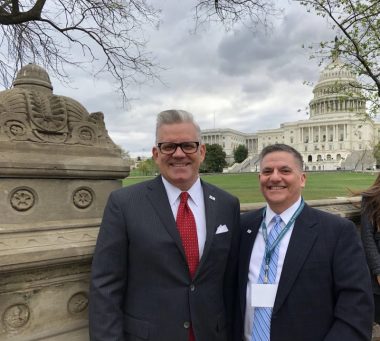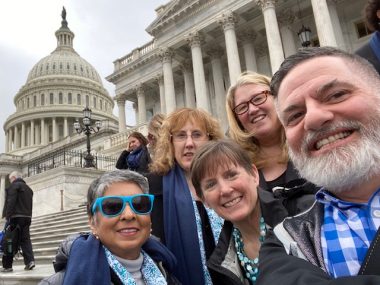How Good Advocacy and Fundraising Drive Scleroderma Research

Like it or not, in many facets of life, money talks. For scleroderma research and development, the largest portion of funding comes from lawmakers in the U.S. Congress.
Since 2016, David Murad has led advocacy efforts and served as director of chapter relations at the Scleroderma Foundation, a national nonprofit organization serving the interests of those affected by scleroderma. The foundation’s 20 chapters and more than 160 support groups help to carry out its three-fold mission of support, education, and research.
I recently discussed with Murad by phone and email a range of topics related to scleroderma, including advocacy, political work, and fundraising. Excerpts follow.
DCW: What are your responsibilities at the Scleroderma Foundation?
DM: I joined the staff with no personal connection to scleroderma. I looked up how to pronounce it before my first interview. I drew from my significant nonprofit experience, an MBA, a master’s degree in theology, and the charm of a Southern accent.
What are some of the challenges of grassroots advocacy?
Asking people to advocate for scleroderma-related issues often resulted in replies like, ‘That’s too political,’ ‘I’m not interested,’ and, ‘Stop pushing a partisan agenda.’ We revised our vocabulary to sound less political and feel more personal. People are comfortable with raising awareness, which isn’t too far removed from engaging in advocacy.

From left, former Scleroderma Foundation CEO Robert Riggs and current Director of Chapter Relations David Murad take a break during Capitol Hill Day in Washington, D.C., on April 17, 2018. (Courtesy of David Murad)
What is the essence of advocacy?
A distinction between awareness and advocacy is the audience. Imagine wearing a scleroderma fundraiser T-shirt to the grocery story. The images and messaging may pique a stranger’s interest to ask about scleroderma. An informed response educates and raises awareness. Sharing the same information with my senator or congressional representative also raises awareness. It’s advocacy, because Congress has the power to affect change for people living with scleroderma.
We train and empower people to draw from personal stories to create impactful statements that support and ask for congressional support.
When meeting with the staff of a senator on the Senate Appropriations Subcommittee on Defense recently, we kicked off the meeting by saying, “The reason we wanted to meet with you is to ask for the senator’s support of the CDMRP Scleroderma Research Program for FY2022. As a member of this committee, we want her to know how important this research funding is to her constituents.” [CDMRP stands for Congressionally Directed Medical Research Programs. For more details about the program, see the previous link and the interview that continues below.]
Scleroderma advocates focus on sharing why ongoing research funding is important to them and to the scleroderma community.
Tell us about an advocacy focused goal you’re most proud of achieving.
I am tremendously proud of what we accomplished in the first six months of 2021. Our goal is for Congress to fund the Scleroderma Research Program at $5 million for fiscal year 2022, as they first did in 2020, and again in 2021.
This year, more than 125 grassroots volunteer advocates from 36 states met with more than 50 U.S. senators to advocate for scleroderma research. We aimed to meet with all 18 members of the U.S. Senate Appropriations Subcommittee on Defense, who decide if the Scleroderma Research Program will be funded for 2022. To date, we have met with 16 of the 18 members.
I have facilitated several meetings with congressional offices and local constituents. One of the greatest privileges of my job is how inspiring it is to witness people draw upon such strength and conviction to share personal, and often painful, details about coping with their disease.
Over the years, relationships between elected officials and their constituents have resulted in key support for the scleroderma community. Former Reps. Peter King (R-NY) and Eliot Engel (D-NY) co-introduced several bills to create a coalition of researchers at the National Institutes of Health that garnered significant bipartisan support.
King and Engel became champions for the scleroderma community because constituents built and maintained relationships with them and their offices. There are many other members of the House and Senate who have gone to bat for us because of relationships forged with constituents.
Converting to a virtual process spiked this year’s level of engagement, which may be the highest in the Scleroderma Foundation’s history. Grassroots advocacy has been the backbone of our program for many years.

From left, Zeba Hyder, Tracy Mieszczak, Cyndy Besselievre, Elizabeth Theisen, and David Murad participate in Rare Disease Week on behalf of the Scleroderma Foundation, during Capitol Hill Day in Washington, D.C., on Feb. 26, 2020. (Courtesy of David Murad)
Where do the scleroderma-targeted funds granted by Congress go?
A direct result is evidenced in the $10 million CDMRP Scleroderma Research Program — soon to be $15 million, if approved for fiscal year 2022. This win for the scleroderma community belongs to the hundreds, if not thousands, of scleroderma advocates who have shared their stories time and again.
None of this funding — not one cent — benefits the Scleroderma Foundation financially. The Scleroderma Research Program funded through the CDMRP is available to experienced scleroderma researchers and new investigators — those new to scleroderma research — to apply for grant funding in support of their research.
How can members of the scleroderma community help?
Every advocacy effort facilitated by the Scleroderma Foundation is designed with the entire scleroderma community in mind to enhance the quality of life of those living with this disease and, ultimately, to find a cure.
It’s up to each and every one of us to contact our representatives at all congressional levels to advance research and find a cure for scleroderma.
To get involved with grassroots advocacy in your state, contact David Murad at [email protected] or [email protected].
***
Note: Scleroderma News is strictly a news and information website about the disease. It does not provide medical advice, diagnosis, or treatment. This content is not intended to be a substitute for professional medical advice, diagnosis, or treatment. Always seek the advice of your physician or other qualified health provider with any questions you may have regarding a medical condition. Never disregard professional medical advice or delay in seeking it because of something you have read on this website. The opinions expressed in this column are not those of Scleroderma News or its parent company, BioNews, and are intended to spark discussion about issues pertaining to scleroderma.








Comments